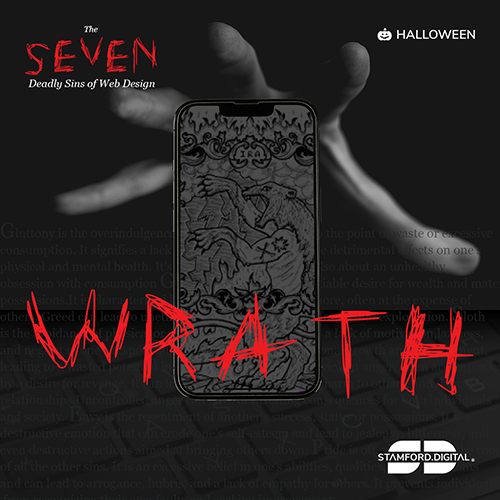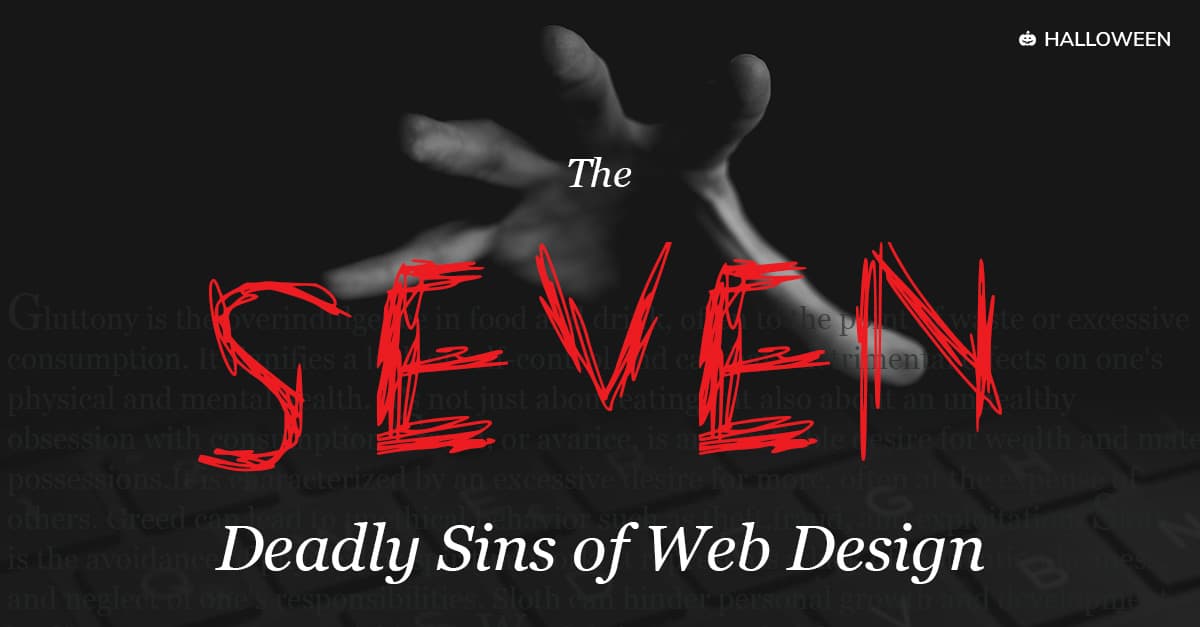1. Pride

Overly flashy web design
We’ve all come across these websites where the balance of form and function is completely out of kilter.
As you scroll down the site you are bombarded with animations and transitions – each more distracting and annoying than the last.
Overly flashy web design might ‘look cool’, however, it could have a detrimental effect on user experience (UX) and the amount of sales/leads that your website generates.
Self-promotion Overload
Building trust and authority in your marketplace is essential, but it is possible to overdo it.
Excessively promoting past achievements or awards on your website, can overshadow the content on your site that highlights the problems your product or service can solve for a customer.
Ignoring user feedback
Dismissing and ignoring user feedback and suggestions, and blindly believing you or your marketing team know best can lead to a disconnected user experience on your website.
In my own experience, websites that generate thousands of pounds in revenue a week can still have the capacity to listen to their user base, improve and do better.
Pride comes before a fall
🤕 Avoid the fall:
👉 Check your site isn’t filled with animations that distract your users from your CTAs and hinder your site’s conversion rate.
👉 Check the content on your website isn’t excessively self-promoting what your business has achieved or won.
Instead, your content should build trust and authority while positioning your business as the guide to help a potential customer/client.
👉 Start listening to your users. Directly ask them how you can do better or review user sessions and look for common trends/problems.
Minor percentage improvements to user journeys have the ability to transform a business.
2. Envy

Ripping off a website’s design
As you’ve browsed various websites you would have spotted some common design patterns in web design (e.g. logo in the top left, navigation on the right, primary CTA above the fold).
For SMEs following tried and tested design patterns is a wise move.
However, if you blatantly copy another website’s design you can not only damage your brand but also run into copyright and legal Issues.
Stealing website content
Plagiarism and content theft are unethical practices that unfortunately persist online.
Businesses resort to stealing website content for various reasons, primarily driven by the desire for quick and easy gains. For example – attempting to boost their organic search result position within Google. However, this can backfire and damage your organic position.
Stealing website content is not only unethical but also illegal in many cases. It can lead to legal action, damaged reputations, and loss of trust from customers and peers.
Scraping data
It’s possible to use existing tools or create a small piece of software that will crawl through a website and ‘scrape’ all of the data.
Many websites protect themselves from this legally with various terms and conditions and terms of use written within their website.
However, sadly this does not deter everyone.
Like above, this is unethical, it can damage your reputation and it can lead to legal action.
Envy is the ulcer of the soul.
Socrates
🤢 Avoid Envy within your website:
👉 Every business is different and a website design should reflect that. Hire a website designer who listens to your unique requirements/objectives and creates you a bespoke website.
👉 Find a website copywriter who can inform and enthuse your audience with original, thought-provoking content.
👉 Build your datasets in an ethical way. Look at creating dedicated landing pages to allow information to be added quickly. Clearly explain the benefits of joining your platform. You could also look at incentivising the process too.
3. Gluttony

Heavy Page Loads
Bloated code, excessive multimedia content, and numerous unoptimised images will slow web pages. This leads to a poor user experience as visitors must wait longer for content to load, potentially driving them away.
Plugin Overload
Excessive plugins can slow down the website, introduce security vulnerabilities, and make maintenance challenging. This problem is a common occurrence with WordPress websites.
Content Explosion
Adding content for the sake of adding content without considering its relevance or quality can harm a website.
We’ve seen a trend of companies leveraging AI (e.g. ChatGPT) to create their content on a mass scale programmatically.
This can impact your website’s user experience and your organic search result position.
Is it time your website got fitter? 🏃♂️
Avoid a gluttonous website:
👉 Hire a professional web developer who understands code. They will be able to guide you and create a fast and efficient website.
👉 Take a minimalist approach to plugins. Regularly audit your plugins and remove what you’re not using. Not only do these bloat your website but they also pose a potential security risk.
👉 It is important to create and publish content on your website regularly. However, don’t fill your website with spammy AI articles. Anyone can do this.
When it comes to content focus on quality over quantity.
4. Greed

Excessive Costs for Basic Features
A greedy web design agency may charge exorbitant fees for standard features and functionalities that are commonly included in website development. This can result in clients overpaying for services that should be reasonably priced.
Hidden Fees and Add-Ons
Hidden fees or promoting unnecessary add-on services that inflate the overall cost of the project. Clients may not realise the true cost until it’s too late.
Cutting Corners to Maximise Profits
A focus on greed can lead to cutting corners in the design and development process. This may involve using low-quality templates, neglecting thorough testing, or skipping essential security measures, all of which can negatively impact the website’s performance and functionality.
Avoid overpaying for your website 💰💰💰
👉 Ask questions about the features and functionality outlined in your website proposal. How will the developer achieve this functionality? Are they essentially reselling a third-party service or product?
👉 A good web developer or agency will be transparent with their pricing. If there are one-off development costs, you need to be clear on what is being delivered for that price. Also, ask about recurring costs. e.g. hosting, website maintenance, etc.
👉 As the client, it’s tricky for you to determine if a web developer or agency is “cutting corners.” After all, you’re paying for their expertise, right?
Remember injecting your content with your knowledge and experience is a key differentiator.
However, here are a few tips that can help:
1. Ensure that the web developer/agency provides a detailed proposal. This proposal should demonstrate that they have clearly understood your brief and project requirements.
2. Check their existing portfolio or ask for previous examples of their work.
3. Before signing off your website, use Google’s PageSpeed Insights tool to check how your new website scores for Performance, Best Practices, Accessibility, and SEO. The report you get back will be incredibly detailed and it will highlight how your web developer can make improvements.
Remember injecting your content with your knowledge and experience is a key differentiator.
5. Lust

Clickbait and Sensationalism
A website that relies on misleading headlines, provocative images, and sensationalised stories to lure visitors can lead to high bounce rates, a damaged reputation, and decreased user engagement.
Overwhelming Visuals
Excessive animations, pop-ups, and intrusive design features that distract and divert users’ attention away from the core content can increase web page abandonment, lower conversion rates, and result in a poorer user experience.
Unwanted Subscriptions and Email Lists
A website that aggressively pushes users to sign up for newsletters, email lists, or memberships without their consent or with deceptive promises of content can lead to increased unsubscribes, higher spam reports, and damage to your brand image.
Avoid the Deadly Sin of LUST on Your Website
👉 Ensure that your content is truthful, accurate, and supported by reliable sources. Avoid making exaggerated claims or using deceptive information.
👉 Focus on a clean and uncluttered design that prioritises clarity and simplicity. Avoid adding excessive visual elements that distract from the core content and the message you are trying to convey.
👉 Offer valuable and relevant content to your subscribers. Engaging content encourages users to stay subscribed and eagerly anticipate your emails.
6. Wrath

Error-Ridden Website
An error-ridden website is one that frequently experiences technical issues, crashes, or contains broken links, resulting in a frustrating user experience. Such technical problems can take various forms, including slow loading times, server errors, unresponsive pages, and malfunctioning features.
You have to get the basics right because users who encounter these issues may just simply abandon the website altogether.
Negative User Experience
A negative user experience on a website is when visitors encounter frustrations or difficulties that hinder their ability to navigate, find information or complete desired actions.
Bad user experiences can result from factors such as an unfriendly website design, poor customer service and unresponsive customer feedback channels.
Users who encounter poor UX are less likely to engage with the site, leading to increased bounce rates and potentially damaging the site’s reputation.
Aggressive Pop-ups and Ads
A website that employs aggressive pop-ups and intrusive advertisements creates a hostile browsing experience for users.
These aggressive advertising tactics include the excessive use of pop-up windows, auto-play videos, flashing banners, and other forms of advertising that disrupt the user’s interaction with the site.
Intrusiveness like this can lead to user frustration, reduced engagement, and a negative perception of the website. Not only that, users may find it challenging to focus on the content and it may deter a user from completing a critical website goal/objective.
😡 Avoid wrathful website design:
👉 Ask your web designer to provide an overview of the infrastructure (e.g. sitemap), conduct regular maintenance, and ensure that all links and features are in working order to prevent user frustration and potential loss of engagement.
I also recommend that you invest and have some automated tests created for critical functionality and user journeys.
👉 Perform basic accessibility checks on your website using Google Lighthouse and ask your web designer to get that accessibility and best practice score as close to 100 as possible.
Also, there are a lot of free online tools and services you can use to help you improve the usability of your website (e.g. Google Analytics, HotJar, FullStory).
👉 Advertising is a key revenue generator and unavoidable for many websites. However, you need to carefully balance adverts with content and consider why your users are visiting your site in the first place.
Keep this in mind and allow your visitors to access content without being bombarded by intrusive ads and pop-ups.
7. Sloth

Lack of Software Updates
A website that neglects essential updates reflects a lack of diligence and security consciousness, which can be equated with the sin of “sloth”.
Hackers often target websites with known security vulnerabilities, taking advantage of the failure to apply updates promptly.
If you own a WordPress website, it’s really important that you keep it up-to-date because you have a particularly large target on your back, as WordPress is used on 43% of websites.
This lack of vigilance in this area not only puts user data and privacy at risk but also compromises your website’s and brand’s reputation.
Outdated Content
Outdated content on a website means that visitors are greeted with information that no longer reflects current events, products, or services.
This lack of effort to keep the website’s content fresh and relevant can be detrimental to your website.
Firstly, it makes the site appear stagnant and disengaging, as users find little incentive to return when they encounter the same outdated information repeatedly.
Secondly, outdated content can negatively impact a website’s search engine ranking, as search engines favour websites that regularly refresh their content to provide the most up-to-date information to users.
Slow Loading Times
The sluggish performance of a website is often due to various issues, such as the presence of large, unoptimised images or inefficient code.
Slow-loading websites reflect a lack of effort from a web designer to provide a smooth and efficient user experience.
Slow loading times can harm the overall user experience and deter users from engaging with the site. If a visitor encounters delays and speed issues, they may grow frustrated and potentially abandon the site.
In fact, Think with Google found that 53% of visits are abandoned if a mobile site takes longer than 3 seconds to load.
Avoid a slothful website design:
👉 Keep your website up-to-date. If you don’t have the time, then I recommend hiring a web developer to stay on top of your site updates. Most developers often offer website maintenance packages.
👉 Aim to add new content to your website on a regular basis. I would recommend refreshing your content at least once a month. Again, if you find that there aren’t enough hours in the day, then I recommend using a copywriter who understands your brand, target audience and business objectives.
👉 I’ve previously recommended this: Use Google Lighthouse as a starting point to check your website’s performance score. It will provide you with a detailed report of the problem areas and information on how to fix them.
That concludes our Seven Deadly Sins of Web Design article.
I hope you found this Halloween special article informative and that it helps your website avoid committing one of the deadly sins of web design.
Happy Halloween 🎃



